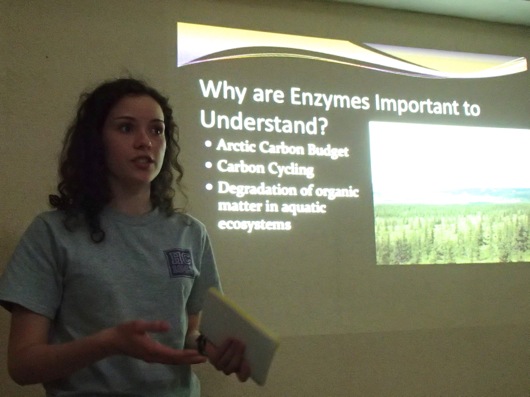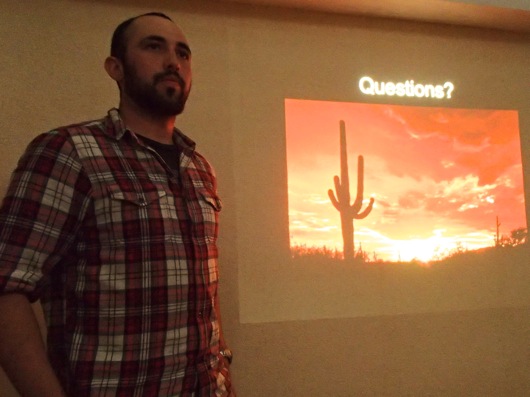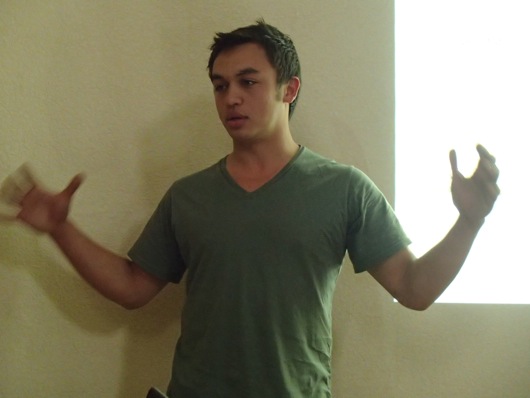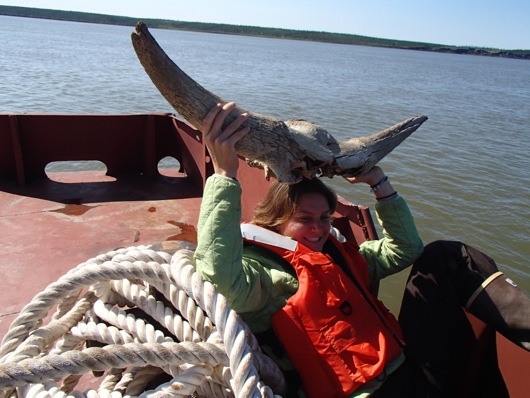(Mark Paricio is a PolarTREC Teacher accompanying the Polaris Project this summer. To read all of Mark’s journals, go to: http://www.polartrec.com/expeditions/siberian-arctic-systems-study )
5th Annual Polaris Project Symposium.
Last evening, the undergraduate and graduate students of the Polaris Project presented the results of their research at the 5th Annual Polaris Project Symposium. To do this, we transformed the dining hall of Orbita into a conference center. Each of these 15 students presented their research for 10 minutes, followed by 5 minutes of questions and answers.
This was an outstanding experience for all to see how a scientific conference is held and the steps necessary to prepare for and give a presentation to a group of scientific peers. The researchers and science staff of the Northeast Science Station evaluated each presentation. Some of the projects I found to be extremely interesting are below.
Maddie LaRue – College of Holy Cross
Maddie, a biology major and the youngest of all the undergraduates at the Polaris Project, presented fascinating research entitled “The Impact of Nutrient Addition on Enzymatic Activity in Waters of the Kolyma River Watershed.”

Maddie LaRue presenting her research of the Impact of Nutrient Addition on Enzymatic Activity in Waters of the Kolyma River Watershed.
In her presentation, this extraordinarily bright student not only gave background on the oxidase and hydrolase enzymes, outlining their roles in the Arctic environment, but used the results of her three week long experiment to correlate enzyme activity with respiration rates, but to explain her results using the double latch mechanism of microbial degradation. As a physics and chemistry teacher, her presentation opened my eyes to an area in which my knowledge is quite limited.
Alfonso Dominguez – Northern Arizona University
Alfonso Dominguez research focused on “Cross Channel Variability of the Kolyma River and its Major Tributaries” in which he analyzed the impacts of tributary inputs into the Kolyma River.

Alfonso Dominguez takes questions at the end of his presentation. The Arizona landscape in his slide contrasted greatly to our environment as a storm blew July snows into Cherskiy.
Using bathymetric analysis (a great way to say finding the shape of the bottom of the river) of the river and coupled with measurements of temperature and specific conductance of the Kolyma River, Alfonso showed that the waters entering the Kolyma River from tributaries do not mix instantly. Rather, these separate waters can still be identified at considerable distances downstream.
Miles Borgen – Western Washington University
Miles, who has also entertained us some evenings with his prodigious guitar skills, presented “Biolability and Composition of Dissolved Organic Matter Leached from the Dominant Endmembers of the Siberian Arctic.”

Miles Borgen gestures during his animated presentation at the 5th Annual Polaris Project Symposium.
For those of us who are newer to the language of biogeochemistry (like myself) this translates into determining how water dissolves plant materials from the soils and vegetation it encounters as it flows. This is important because this carbon containing material gets transported into the environment and eventually into the atmosphere at different rates, potentially affecting the carbon dioxide levels in the air. The strength of Miles’ presentation was his clear explanation of the elaborate analyses he has performed at the station.
Kelsey Dowdy – University of California at Santa Barbara
Kelsey’s research question, “Does ice wedge water control the biolability of old carbon?” looked at the role that water from the 40,000 year old ice wedges melting at the Duvannyi Yar site (See my PolarTREC journal from July 12) plays in the releasing the carbon stored in ancient permafrost soils. Kelsey’s research indicates that water from any source activated the decomposition of the stored carbon and that, as the water from melting ice wedges is the most available source at Duvannyi Yar, it does indeed play a significant role.

Kelsey Dowdy, always livening up the day, demonstrates the use of ancient bison horns on our barge trip to Duvannyi Yar where her ice wedge samples were collected.
What next?
As the student projects were compressed into a three-week frenzy of Arctic science, there is still much to do on their projects and the papers they will write as part of their participation in the Polaris Project (abstracts are due in 15 days!). Particularly impressive is the emphasis to make their methodologies and data available to future scientists to use. Since every field project can be improved or expanded, this type of sharing within the scientific community lays the groundwork for future investigations.
Perhaps of equal value, this opportunity to present in a very professional atmosphere to an audience of scientific researchers and peers, provides a foundation on which these students can build their future careers.
Stay curious my friends! – Mark Paricio



